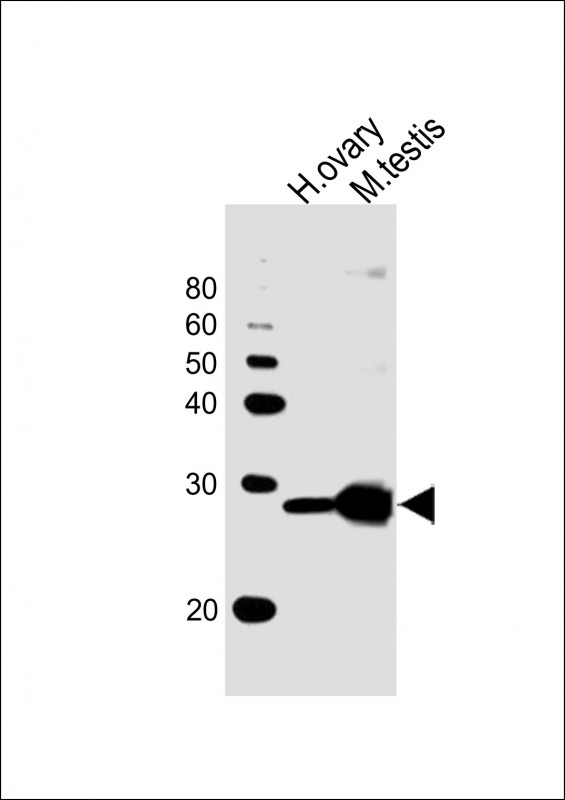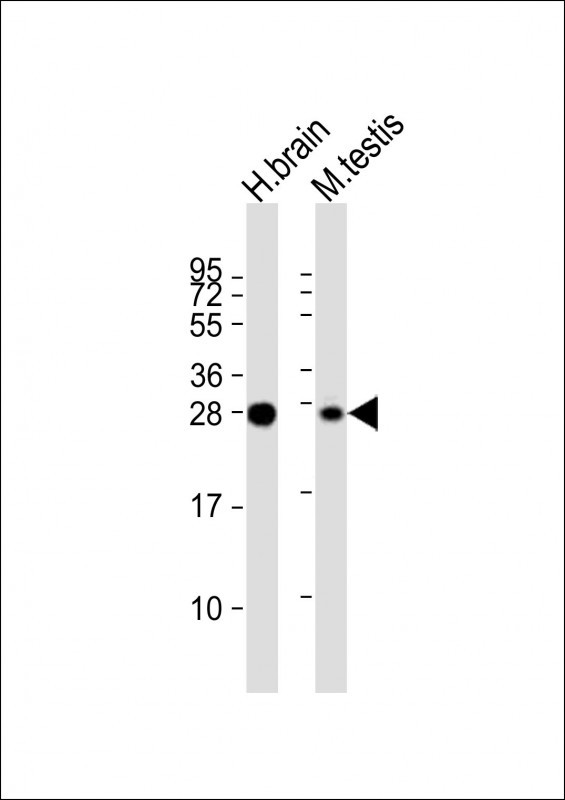PLD6 Antibody (Center)
Affinity Purified Rabbit Polyclonal Antibody (Pab)
- SPECIFICATION
- CITATIONS
- PROTOCOLS
- BACKGROUND

Application
| WB |
|---|---|
| Primary Accession | Q8N2A8 |
| Reactivity | Human, Mouse |
| Host | Rabbit |
| Clonality | Polyclonal |
| Calculated MW | H=28;M=25 KDa |
| Isotype | Rabbit IgG |
| Antigen Source | HUMAN |
| Gene ID | 201164 |
|---|---|
| Antigen Region | 140-174 aa |
| Other Names | Mitochondrial cardiolipin hydrolase, 31--, Choline phosphatase 6, Mitochondrial phospholipase, MitoPLD, Phosphatidylcholine-hydrolyzing phospholipase D6, Phospholipase D6, PLD 6, Protein zucchini homolog, PLD6 |
| Dilution | WB~~1:2000 |
| Target/Specificity | This PLD6 antibody is generated from rabbits immunized with a KLH conjugated synthetic peptide between 125-174 amino acids from the Central region of human PLD6. |
| Storage | Maintain refrigerated at 2-8°C for up to 2 weeks. For long term storage store at -20°C in small aliquots to prevent freeze-thaw cycles. |
| Precautions | PLD6 Antibody (Center) is for research use only and not for use in diagnostic or therapeutic procedures. |
| Name | PLD6 |
|---|---|
| Function | Presents phospholipase and nuclease activities, depending on the different physiological conditions (PubMed:17028579, PubMed:21397847, PubMed:28063496). Interaction with Mitoguardin (MIGA1 or MIGA2) affects the dimer conformation, facilitating the lipase activity over the nuclease activity (PubMed:26711011). Plays a key role in mitochondrial fusion and fission via its phospholipase activity (PubMed:17028579, PubMed:24599962, PubMed:26678338). In its phospholipase role, it uses the mitochondrial lipid cardiolipin as substrate to generate phosphatidate (PA or 1,2-diacyl-sn-glycero-3- phosphate), a second messenger signaling lipid (PubMed:17028579, PubMed:26711011). Production of PA facilitates Mitofusin-mediated fusion, whereas the cleavage of PA by the Lipin family of phosphatases produces diacylgycerol (DAG) which promotes mitochondrial fission (PubMed:24599962). Both Lipin and DAG regulate mitochondrial dynamics and membrane fusion/fission, important processes for adapting mitochondrial metabolism to changes in cell physiology. Mitochondrial fusion enables cells to cope with the increased nucleotide demand during DNA synthesis (PubMed:26678338). Mitochondrial function and dynamics are closely associated with biological processes such as cell growth, proliferation, and differentiation (PubMed:21397848). Mediator of MYC activity, promotes mitochondrial fusion and activates AMPK which in turn inhibits YAP/TAZ, thereby inducing cell growth and proliferation (PubMed:26678338). The endonuclease activity plays a critical role in PIWI-interacting RNA (piRNA) biogenesis during spermatogenesis (PubMed:21397847, PubMed:21397848). Implicated in spermatogenesis and sperm fertility in testicular germ cells, its single strand-specific nuclease activity is critical for the biogenesis/maturation of PIWI-interacting RNA (piRNA). MOV10L1 selectively binds to piRNA precursors and funnels them to the endonuclease that catalyzes the first cleavage step of piRNA processing to generate piRNA intermediate fragments that are subsequently loaded to Piwi proteins. Cleaves either DNA or RNA substrates with similar affinity, producing a 5' phosphate end, in this way it participates in the processing of primary piRNA transcripts. piRNAs provide essential protection against the activity of mobile genetic elements. piRNA- mediated transposon silencing is thus critical for maintaining genome stability, in particular in germline cells when transposons are mobilized as a consequence of wide-spread genomic demethylation (By similarity). PA may act as signaling molecule in the recognition/transport of the precursor RNAs of primary piRNAs (PubMed:21397847). Interacts with tesmin in testes, suggesting a role in spermatogenesis via association with its interacting partner (By similarity). |
| Cellular Location | Mitochondrion outer membrane; Single-pass membrane protein. Golgi apparatus {ECO:0000250|UniProtKB:Q5SWZ9}. Note=Localization in the mitochondrial outer membrane is found in different cell types where phospholipase is the predominant activity, however, in pachytene spermatocytes and spermatids of mouse testes where nuclease activity is predominant, localization is restricted to the Golgi, suggesting this enzyme is localized in different subcellular compartments depending on the role (phospholipase or nuclease) it needs to play in each cell type and developmental stage. |
| Tissue Location | Predominantly expressed in testis and ovary, but not limited to gonads (at protein level) (PubMed:17028579, PubMed:21397847). It is also found in brain, heart, pituitary gland, prostate, pancreas, thyroid, bone marrow, lung and muscle (PubMed:21397847). |

Thousands of laboratories across the world have published research that depended on the performance of antibodies from Abcepta to advance their research. Check out links to articles that cite our products in major peer-reviewed journals, organized by research category.
info@abcepta.com, and receive a free "I Love Antibodies" mug.
Provided below are standard protocols that you may find useful for product applications.
If you have used an Abcepta product and would like to share how it has performed, please click on the "Submit Review" button and provide the requested information. Our staff will examine and post your review and contact you if needed.
If you have any additional inquiries please email technical services at tech@abcepta.com.













 Foundational characteristics of cancer include proliferation, angiogenesis, migration, evasion of apoptosis, and cellular immortality. Find key markers for these cellular processes and antibodies to detect them.
Foundational characteristics of cancer include proliferation, angiogenesis, migration, evasion of apoptosis, and cellular immortality. Find key markers for these cellular processes and antibodies to detect them. The SUMOplot™ Analysis Program predicts and scores sumoylation sites in your protein. SUMOylation is a post-translational modification involved in various cellular processes, such as nuclear-cytosolic transport, transcriptional regulation, apoptosis, protein stability, response to stress, and progression through the cell cycle.
The SUMOplot™ Analysis Program predicts and scores sumoylation sites in your protein. SUMOylation is a post-translational modification involved in various cellular processes, such as nuclear-cytosolic transport, transcriptional regulation, apoptosis, protein stability, response to stress, and progression through the cell cycle. The Autophagy Receptor Motif Plotter predicts and scores autophagy receptor binding sites in your protein. Identifying proteins connected to this pathway is critical to understanding the role of autophagy in physiological as well as pathological processes such as development, differentiation, neurodegenerative diseases, stress, infection, and cancer.
The Autophagy Receptor Motif Plotter predicts and scores autophagy receptor binding sites in your protein. Identifying proteins connected to this pathway is critical to understanding the role of autophagy in physiological as well as pathological processes such as development, differentiation, neurodegenerative diseases, stress, infection, and cancer.



